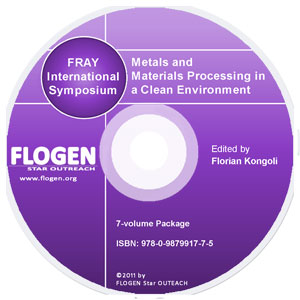
CD shopping page |
2011-Sustainable Industrial Processing Summit
|
| Editors: | Florian K |
| Publisher: | Flogen Star OUTREACH |
| Publication Year: | 2012 |
| Pages: | 646 pages |
| ISBN: | 978-0-9879917-6-8 |
| ISSN: | 2291-1227 (Metals and Materials Processing in a Clean Environment Series) |
Fabrication Of High-Strength, Lightweight, Nanostructured Metal Matrix Composites
Tony Zahrah1; Deepak Kapoor2;1MATSYS, INC., Sterling, United States; 2US ARMY, Picatinny Arsenal, United States;
Type of Paper: Regular
Id Paper: 292
Topic: 9
Abstract:
Bulk nanocrystalline materials have shown significant improvement in mechanical behavior as compared to microcrystalline materials of similar compositions. The enhanced properties are attributed to the strengthening from the grain refinement and from the introduction of a secondary reinforcement into the matrix. The extent of strengthening from the secondary reinforcement is greatly dependent on the dispersion of the reinforcement within the matrix and the strength of the interfacial bonding, which allows for effective load transfer from the matrix to the reinforcement, leading to improved stiffness, strength, and ductility. A two-step approach is used to produce bulk nanocrystalline materials. First, a top down approach such as high energy milling is used to fabricate nanostructured composite powders. This mechanical alloying process allows one to homogeneously disperse a reinforcement phase within the matrix while simultaneously creating a super saturated nano-grained microstructure and a clean metallurgical interface between the reinforcement and the matrix. The nanostructured powders are then consolidated by a variety of techniques, including Hot Isostatic Press (HIP) uniquely equipped with a high temperature eddy current sensor to monitor in real-time the densification of the composite powder, Microwave Sintering, and Field Assisted Sintering Technology (FAST). These novel consolidation techniques serve to minimize the exposure of the nanocrystalline composite powder to deleterious combinations of high temperatures and long soak times, thus preventing excessive grain growth and preserving the engineered nanostructure of the starting powders. We have successfully fabricated a variety of fully dense metal matrix composites with an aluminum matrix reinforced with either B4C or carbon nanotubes (CNT). The compressive strength of the Al5083-B4C composite reached 900 MPa. Metallographic and mechanical characterization has shown a good dispersion of CNTs in the final composite. The addition of 1 wt% CNT results in a 10% increase in tensile strength as compared to a pure Al baseline. This paper will discuss the effects of composition on the consolidation behavior and mechanical properties of these nanostructured lightweight composites.